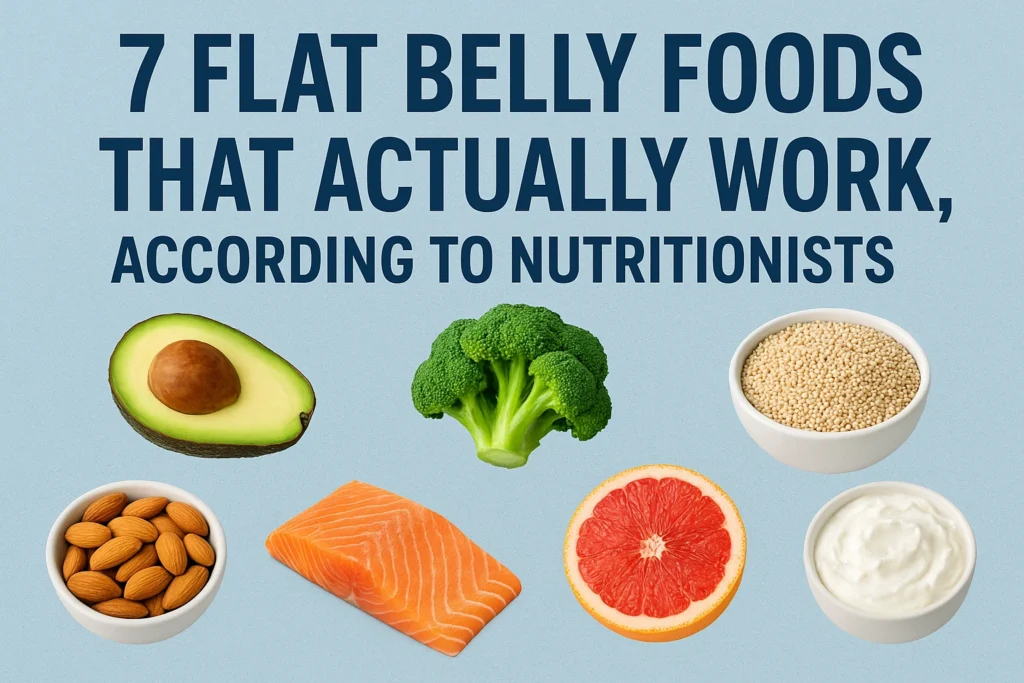7 Flat Belly Foods That Actually Work, According to Nutritionists
✨Fuel Your Body, Fight the Belly Fat.✨
Start Your Flat Belly JourneyTable of Contents

Introduction
Why Belly Fat Is Hard to Lose
Losing belly fat is often harder than dropping fat from other parts of the body — and that’s not just your imagination. It’s backed by science.
Visceral Fat: The Real Problem
Belly fat is made up of two main types:
Subcutaneous fat – the soft fat under the skin
Visceral fat – the deep fat surrounding your internal organs
Visceral fat is especially dangerous because it increases your risk of type 2 diabetes, heart disease, and chronic inflammation.
According to Harvard Health, visceral fat is also more metabolically active and resistant to breakdown than other types of fat, which makes it harder to lose through regular diet and exercise.
Source: Harvard Health – Abdominal Fat
Hormones Make It Even Tougher
Hormones — particularly cortisol, the stress hormone — have a major impact on belly fat storage. When you’re stressed, your body tends to store fat in the abdominal area, even if your calorie intake isn’t very high.
Women going through menopause are especially prone to belly fat because of hormonal changes. As estrogen levels decline, the body tends to shift fat storage from the hips and thighs to the midsection.
According to the Mayo Clinic, hormonal changes after menopause directly contribute to increased belly fat in women.
Why Typical Diets Don’t Work on Belly Fat
Most popular diets (like low-carb, juice cleanses, or low-fat) may help reduce overall weight, but they often fail to target belly fat specifically because they don’t address the underlying issues:
Stress
Hormonal imbalance
Lack of sleep
Sedentary lifestyle
Poor gut health
To effectively reduce belly fat, you need a long-term approach — not quick fixes. This includes:
Managing stress with mindfulness or yoga
Sleeping 7–9 hours regularly
Combining cardio with strength training
Eating more whole, fiber-rich foods
Staying hydrated and supporting digestion
What Doctors Say
“Spot reduction doesn’t work. You can’t target belly fat alone. A combination of total fat loss, muscle strengthening, and hormonal balance is key.”
— Dr. Fatima Cody Stanford, Obesity Medicine Physician, Harvard Medical School
Final Takeaway
Belly fat is stubborn because it’s not just about what you eat — it’s also about your hormones, sleep, stress, and activity levels. It’s often the last fat to go, but with consistency, it will go.
So don’t just count calories — focus on lifestyle. In the next section, we’ll share 7 nutritionist-approved foods that actually help fight belly fat from the inside out.
💡 Related Reading:
• Flat Belly After 40: Science-Based Plan for Women
The Role of Nutrition in Belly Fat
What you eat plays a crucial role in how much belly fat your body stores and how effectively you can lose it. Nutrition affects belly fat not only through calories but also by influencing hormones, inflammation, and metabolism.
How Nutrition Influences Belly Fat
Certain foods can promote fat storage, especially around the abdomen. For example, diets high in refined sugars and processed carbohydrates spike insulin levels, encouraging the body to store fat, particularly visceral fat, which surrounds vital organs and poses health risks.
On the other hand, eating whole, nutrient-dense foods supports fat loss by:
Balancing blood sugar and insulin levels
Reducing chronic inflammation
Promoting a healthy metabolism
A diet rich in fiber, healthy fats, lean protein, and antioxidants helps curb hunger, improve digestion, and boost energy expenditure, all of which contribute to reducing belly fat.
Real Facts from Research
A study published in the Journal of Nutrition found that increasing dietary fiber intake significantly reduces abdominal fat by improving satiety and reducing overall calorie intake.
According to Harvard T.H. Chan School of Public Health, replacing sugary drinks with water or unsweetened beverages is one of the simplest changes to reduce belly fat and improve metabolic health.
Research also shows that foods rich in omega-3 fatty acids, like fatty fish and flaxseeds, help reduce visceral fat by lowering inflammation and improving insulin sensitivity.
What Experts Recommend
Dr. Walter Willett, Professor of Epidemiology and Nutrition at Harvard T.H. Chan School of Public Health, emphasizes:
“Focus on whole, minimally processed foods, plenty of vegetables, nuts, and lean proteins. Avoid sugary drinks and excess refined carbs. These dietary habits are strongly linked with less abdominal fat.”
Similarly, the Mayo Clinic advises that cutting down on added sugars, especially fructose found in soft drinks and many processed foods, can lead to a noticeable reduction in belly fat.
Key Nutritional Tips to Combat Belly Fat
Eat plenty of fiber: Beans, lentils, vegetables, fruits, and whole grains
Include healthy fats: Avocados, nuts, olive oil, and fatty fish
Prioritize lean proteins: Eggs, chicken, tofu, and legumes
Limit added sugars and refined carbs: Avoid sodas, pastries, white bread
Stay hydrated: Drinking enough water aids digestion and reduces bloating
Conclusion
Nutrition is one of the strongest tools you have to fight belly fat. It’s not just about cutting calories but about choosing foods that help balance hormones, reduce inflammation, and boost metabolism. A sustainable, whole-food-based diet makes belly fat easier to lose and keeps it off for good.
💡 Related Reading:
👉Top 5 Belly Fat Burning Yoga Poses for Women Over 40
7 Flat Belly Foods That Actually Work
Greek Yogurt: A Flat Belly Superfood
Greek yogurt is more than just a creamy snack — it’s a powerful ally in the fight against belly fat.
Why Greek Yogurt?
High in Protein:
Greek yogurt packs almost double the protein of regular yogurt. Protein boosts metabolism and promotes satiety, which helps reduce overall calorie intake. Studies show higher protein diets are linked with reduced abdominal fat.Rich in Probiotics:
The probiotics in Greek yogurt improve gut health by balancing your microbiome. A healthy gut helps reduce inflammation and may prevent fat storage around the belly.Low in Sugar:
Unlike flavored yogurts, plain Greek yogurt has very little sugar. Excess sugar, especially fructose, encourages belly fat accumulation.
What Experts Say
The Mayo Clinic highlights that high-protein dairy foods like Greek yogurt help regulate appetite and improve body composition, making it a smart choice for belly fat reduction.
How to Include Greek Yogurt in Your Diet
Swap sugary breakfast cereals for Greek yogurt topped with berries and nuts.
Use it as a creamy base for smoothies or salad dressings.
Enjoy it as a snack with a sprinkle of cinnamon or chia seeds.
- 💡 Related Reading:
👉Top Anti‑Inflammatory Foods to Reduce Belly Fat for Women Over 40
Avocados: Healthy Fats That Fight Belly Fat
Avocados are often called a superfood, and for good reason — their unique fat profile makes them a great choice for anyone looking to lose belly fat.
Why Avocados?
Rich in Monounsaturated Fats:
Avocados are loaded with heart-healthy monounsaturated fats, which help reduce bad cholesterol and promote fat loss, especially in the abdominal area. Unlike saturated fats, these fats support better insulin sensitivity, which is crucial for managing belly fat.High in Fiber:
One avocado provides about 10 grams of fiber — a nutrient known to keep you full longer, regulate blood sugar, and reduce fat accumulation around the belly.Loaded with Nutrients:
Besides fats and fiber, avocados are packed with vitamins, minerals, and antioxidants that reduce inflammation and support metabolism.
What the Research Says
A study published in Nutrition Journal found that people who regularly ate avocados had lower BMI, smaller waist circumference, and better overall diet quality.
According to Harvard T.H. Chan School of Public Health, monounsaturated fats found in avocados are linked with less abdominal fat compared to diets high in saturated fats.
How to Add Avocados to Your Diet
Add sliced avocado to salads, sandwiches, or toast for a creamy texture and healthy fats.
Blend avocados into smoothies for extra creaminess and nutrition.
Use mashed avocado as a healthier substitute for mayonnaise or butter.
- 💡 Related Reading:
👉 10 Proven Ways to Burn Belly Fat After 40
Green Tea: A Natural Metabolism Booster for Belly Fat
Green tea is more than just a soothing drink — it’s a scientifically supported tool to help reduce stubborn belly fat.
Why Green Tea?
Rich in Catechins:
Green tea contains antioxidants called catechins, especially EGCG (epigallocatechin gallate), which have been shown to boost metabolism and increase fat burning, particularly around the abdominal area.Enhances Fat Oxidation:
Studies show that green tea can increase fat oxidation during exercise and at rest, helping the body use fat as fuel more efficiently.Supports Insulin Sensitivity:
Better insulin sensitivity means your body handles sugar more effectively, reducing the likelihood of excess fat storage around the belly.
What Research Shows
A review published in the Journal of the American College of Nutrition found that green tea catechins, combined with caffeine, significantly reduce body fat, especially visceral fat.
Harvard Health also notes that regular green tea consumption may help reduce belly fat and improve metabolic health over time.
How to Incorporate Green Tea into Your Routine
Drink 2-3 cups of unsweetened green tea daily for best results.
Swap sugary beverages with green tea to cut excess calories and sugar.
Try matcha, a powdered form of green tea, for a concentrated antioxidant boost.=
- 💡 Related Reading:
👉 10 Proven Ways to Burn Belly Fat After 40
Berries: Antioxidant Powerhouses for a Flatter Belly
Berries like blueberries, strawberries, raspberries, and blackberries are not only delicious but also excellent foods to help fight belly fat.
Why Berries?
High in Fiber:
Berries are packed with dietary fiber, which promotes fullness, regulates blood sugar, and reduces fat storage, especially around the belly.Rich in Antioxidants:
They contain powerful antioxidants called polyphenols that combat inflammation and oxidative stress—both linked to excess belly fat.Low in Calories and Sugar:
Compared to many fruits, berries are low in calories and have a lower glycemic index, meaning they don’t cause blood sugar spikes that can lead to fat accumulation.
What Science Says
A study published in Nutrients highlights that berry consumption improves metabolic health and may reduce abdominal fat through anti-inflammatory effects.
Harvard Health points out that eating fruits like berries regularly is associated with lower waist circumference and better weight management.
How to Add Berries to Your Diet
Top your Greek yogurt or oatmeal with fresh or frozen berries.
Blend berries into smoothies for a nutrient-rich boost.
Snack on a handful of mixed berries instead of processed sweets.
- 💡 Related Reading:
👉Lose Belly Fat After 40: Proven Strategies for Women
Leafy Greens: Nutrient-Dense Allies Against Belly Fat
Leafy greens like spinach, kale, Swiss chard, and arugula are some of the best foods you can eat to help reduce belly fat and improve overall health.
Why Leafy Greens?
Low in Calories, High in Fiber:
Leafy greens are very low in calories but rich in fiber, which helps keep you full longer and supports healthy digestion — both important for reducing belly fat.Packed with Vitamins and Minerals:
They contain important nutrients like vitamins A, C, K, magnesium, and antioxidants that help reduce inflammation and support metabolism.Support Blood Sugar Control:
Eating leafy greens can improve insulin sensitivity, which helps prevent fat storage around the abdomen.
What Research Says
According to a study published in The Journal of Nutrition, diets rich in leafy greens are associated with lower body weight and less abdominal fat.
Harvard T.H. Chan School of Public Health recommends including plenty of vegetables, especially leafy greens, for effective weight management.
How to Incorporate Leafy Greens
Add fresh spinach or kale to smoothies for an easy nutrient boost.
Use leafy greens as the base for salads topped with lean proteins and healthy fats.
Stir-fry Swiss chard or sauté arugula as a delicious side dish.
💡 Related Reading:
Want to see how real women track and adapt their flat belly journey?
👉 Flat Belly After 40: Science-Based Plan for Real Result
Eggs: Protein-Packed and Belly Fat Friendly
Eggs are a nutritional powerhouse and a fantastic food choice when aiming to reduce belly fat.
Why Eggs?
High in Quality Protein:
Eggs provide complete protein, which helps boost metabolism, preserve muscle mass during weight loss, and keep you feeling full longer. This satiety can prevent overeating and aid belly fat reduction.Low in Calories:
Despite being nutrient-dense, eggs are relatively low in calories, making them an efficient choice for weight management.Rich in Essential Nutrients:
Eggs contain important vitamins and minerals like vitamin B12, choline, and selenium, which support overall metabolic health.
What the Science Says
A study published in the International Journal of Obesity found that eating eggs for breakfast leads to reduced calorie intake throughout the day and greater weight loss, including reductions in abdominal fat.
Experts at the Mayo Clinic also highlight eggs as an excellent food to help with weight loss and belly fat control due to their protein content and ability to increase fullness.
How to Include Eggs in Your Diet
Start your day with a protein-packed egg breakfast like boiled eggs or scrambled eggs with veggies.
Use eggs in salads or as a quick snack.
Incorporate eggs into meals like omelets, frittatas, or egg muffins.
- 💡 Related Reading:
Top Anti‑Inflammatory Foods to Reduce Belly Fat for Women Over 40
Nuts & Seeds: Nutrient-Dense Snacks to Combat Belly Fat
Nuts and seeds are small but mighty foods that play a powerful role in reducing belly fat and improving overall health.
Why Nuts & Seeds?
Rich in Healthy Fats:
Loaded with heart-healthy monounsaturated and polyunsaturated fats, nuts and seeds help improve insulin sensitivity and reduce inflammation, which are key for losing stubborn belly fat.High in Protein and Fiber:
The combination of protein and fiber in nuts and seeds helps control hunger and stabilize blood sugar levels, preventing overeating and fat accumulation.Packed with Micronutrients:
They provide essential vitamins, minerals, and antioxidants like magnesium, vitamin E, and zinc, supporting metabolism and fat loss.
What Research Shows
A review in The American Journal of Clinical Nutrition indicates that regular consumption of nuts is linked to lower body weight and reduced abdominal fat, partly because they improve metabolic health and satiety.
According to Harvard Health, including nuts like almonds, walnuts, and seeds such as chia or flaxseeds in your diet supports weight management and heart health.
Source: Harvard Health – Nuts and Weight
How to Add Nuts & Seeds to Your Diet
Sprinkle chia seeds or flaxseeds on your yogurt, oatmeal, or smoothies.
Snack on a handful of raw or roasted nuts like almonds, walnuts, or pistachios.
Add seeds and nuts to salads or homemade energy bars for extra crunch and nutrition.
💡 Related Reading:
🚫 Worst Foods Causing Belly Fat After 40 – Stop Eating These
Bonus Tips
Meal Timing & Portion Control: Keys to Managing Belly Fat
When it comes to losing belly fat, what you eat is important — but so is when and how much you eat. Proper meal timing and portion control can significantly enhance fat loss and improve metabolic health.
Why Meal Timing Matters
Eating at consistent times helps regulate your body's internal clock, known as the circadian rhythm, which influences hormone levels like insulin and cortisol. Avoiding late-night meals can prevent unnecessary fat storage, especially around the belly.
Research from The Journal of Nutritional Biochemistry highlights that eating earlier in the day supports better weight management and metabolic health.
Importance of Portion Control
Even healthy foods can contribute to weight gain if eaten in large quantities. Controlling portion sizes helps maintain a calorie deficit necessary for fat loss without feeling deprived.
Experts at the Mayo Clinic recommend using smaller plates, measuring portions, and listening to hunger cues to avoid overeating.
Tips for Effective Meal Timing & Portion Control
- Eat 3 balanced meals with 1-2 healthy snacks spaced evenly throughout the day.
- Avoid skipping meals to prevent excessive hunger and binge eating.
- Practice mindful eating by slowing down and savoring each bite.
- Use smaller plates and bowls to naturally reduce portion sizes.
- Plan meals ahead to avoid impulsive, unhealthy food choices.
By combining smart meal timing with portion control, you create a sustainable routine that helps reduce belly fat and improves overall health.
Stay Hydrated: Essential for Belly Fat Reduction
Proper hydration is often overlooked but plays a crucial role in managing belly fat and overall health.
Why Hydration Matters
- Boosts Metabolism: Drinking enough water can temporarily increase your metabolism, helping your body burn more calories throughout the day.
- Controls Appetite: Sometimes, thirst is mistaken for hunger. Staying hydrated helps reduce unnecessary snacking and calorie intake.
- Aids Digestion & Reduces Bloating: Water supports healthy digestion and prevents water retention, which can make your belly look bloated and distended.
What Experts Say
According to the Mayo Clinic, drinking water before meals can help with weight loss by making you feel fuller, which leads to consuming fewer calories.
Source: Mayo Clinic – Water: How Much Should You Drink?
Tips to Stay Hydrated
- Aim for at least 8 glasses (about 2 liters) of water daily, more if you’re active.
- Replace sugary drinks with water or herbal teas.
- Carry a reusable water bottle to remind yourself to drink regularly.
- Include water-rich foods like cucumbers, watermelon, and oranges in your diet.
Practice Mindful Eating: Transform Your Relationship with Food
Mindful eating is a powerful approach to managing belly fat by helping you tune into your body’s hunger and fullness signals. It encourages eating with awareness and without distraction, which can prevent overeating and emotional eating.
Why Mindful Eating Works
- Enhances Awareness: Paying attention to the taste, texture, and aroma of food helps you enjoy meals more and recognize when you’re satisfied.
- Reduces Overeating: Slowing down during meals allows your brain time to register fullness, decreasing the chances of overeating.
- Improves Digestion: Eating slowly promotes better digestion and nutrient absorption.
What Experts Say
According to research published in the Journal of Obesity, mindful eating techniques can reduce binge eating and support weight loss by improving eating behaviors.
The Harvard T.H. Chan School of Public Health also emphasizes that mindful eating encourages healthier food choices and better portion control.
Source: Harvard T.H. Chan School of Public Health – Mindful Eating
Tips to Practice Mindful Eating
- Eat without distractions like TV, smartphones, or computers.
- Take small bites and chew thoroughly to savor flavors.
- Pause between bites to check in with your hunger and fullness.
- Notice emotional triggers that lead to eating when you’re not hungry.
- Focus on gratitude and appreciation for your food and the effort behind it.
Final Takeaway: Embrace Your Flat Belly Lifestyle
Real transformation doesn't come from crash diets or overnight promises. It begins with small, intentional choices — choosing whole foods, moving mindfully, and prioritizing rest, hydration, and self-respect.
A flatter belly is a byproduct of balance, not burnout. When you nourish your body and mind with consistency and care, results will follow — naturally and sustainably.
🌟 You don’t need perfection. You just need to start — and stay committed. Progress is power.
Frequently Asked Questions
Visible changes can occur within 3–4 weeks of consistent nutrition, sleep, and exercise. However, sustainable fat loss is a long-term journey and varies per individual.
No single food can target belly fat directly, but whole foods like leafy greens, berries, Greek yogurt, and healthy fats support fat-burning and metabolic health.
Yes. Moderate cardio, walking, strength training, and lifestyle changes (like reducing stress and sleeping better) are all effective for fat loss without extreme workouts.
Intermittent fasting can help some people reduce calorie intake and improve insulin sensitivity, both of which may support belly fat loss. Always consult a healthcare provider before trying it.
Start with One Change Today
Commit to a healthier, stronger you. With a proven, science-backed plan tailored for real life, your flat belly transformation is just 30 days away.
Join Now — Let’s Get StartedGet Answers From the Pros
|










